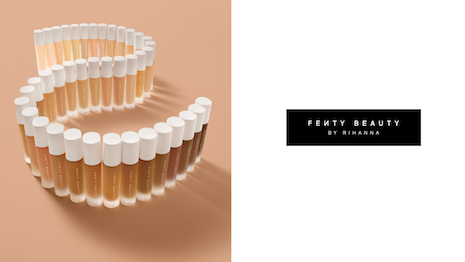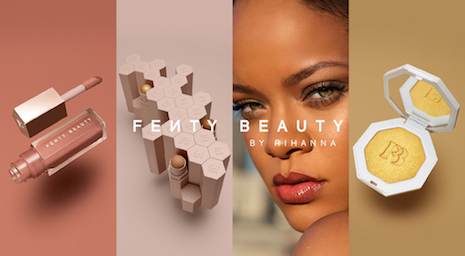 Fenty Beauty was developed by LVMH's Kendo. Image credit: Kendo
Fenty Beauty was developed by LVMH's Kendo. Image credit: Kendo
Fenty Beauty’s entry into the cosmetics arena has shed light on beauty power players’ lack of merchandise diversity for complexion products.
Created by frequent luxury collaborator Rihanna, Fenty Beauty launched following months of anticipation and two years of research and development on Sept. 8. The line of color cosmetics, including a staggering 40 shades of foundation, was developed in partnership with LVMH-owned Kendo, the company behind Bite Beauty and Marc Jacobs Beauty.
Beauty for all
Rihanna’s mission for Fenty Beauty was to create beauty products for hard-to-match skin tones "so that women everywhere would be included," after she found it difficult to find products for her complexion.
In a statement shared to the Fenty Beauty Instagram account, Rihanna explained her cosmetic concept, saying, "I wanted [Fenty Beauty] to be something that girls love, for it to be respected by professionals and I wanted something that felt like me -- reflective of makeup I love and I generally want to wear.
"We have this amazing connection with customers who've never been able to find their shade of foundation before -- women crying at the [makeup] counter -- it's crazy to even think about," she said.
 Rihanna worked with LVMH-owned Kendo on Fenty Beauty. Image credit: Fenty Beauty
"The first woman I saw put makeup on her face was a black woman -- my mom -- and when I think of my customers, I want everyone to feel like they can find their color, that they are represented as part of this new generation."
As a result, Fenty Beauty’s $34 Pro Filt’R foundation is available in a “boundary-breaking” 40 shades, ranging from light and medium to tan and deep.
At launch, Fenty Beauty face products went viral as vloggers, amateur and well-known influencers alike, expressed their joy in finding face makeup that matched their complexion, some for the first time.
While women of darker complexions are often underserved and underrepresented by the beauty industry, even very pale-skinned women were surprised at Fenty Beauty's inclusion of lighter-than-usual shades.
Rihanna worked with LVMH-owned Kendo on Fenty Beauty. Image credit: Fenty Beauty
"The first woman I saw put makeup on her face was a black woman -- my mom -- and when I think of my customers, I want everyone to feel like they can find their color, that they are represented as part of this new generation."
As a result, Fenty Beauty’s $34 Pro Filt’R foundation is available in a “boundary-breaking” 40 shades, ranging from light and medium to tan and deep.
At launch, Fenty Beauty face products went viral as vloggers, amateur and well-known influencers alike, expressed their joy in finding face makeup that matched their complexion, some for the first time.
While women of darker complexions are often underserved and underrepresented by the beauty industry, even very pale-skinned women were surprised at Fenty Beauty's inclusion of lighter-than-usual shades.
The Fenty Beauty Web site suggests trying a lighter shade if stuck between deciding on two shades. Fenty Beauty’s formula is highly pigmented and may appear slightly deeper when the foundation dries on skin. Aside from ranges of illuminating powders, contour and highlighting sticks and eyeshadows developed for wearability across complexions, Fenty Beauty also offers a single “universal” lip gloss. Fenty Beauty’s Gloss Bomb comes in a single rose nude shade, dubbed the “unicorn of nudes” as it looks good on everyone. Available exclusively at retailers Sephora and Harvey Nichols, as well as Fenty Beauty’s ecommerce site, stock flew off the shelves as women gravitated toward the beauty’s inclusive message and merchandising. The success of Fenty Beauty’s inclusive complexion merchandising has also underscored the greater cosmetics sector’s shortcomings in creating products for all consumers. Shades for all | Fenty Beauty Commonly, beauty brands offer foundations in light, medium and dark formulas, but often do not go deep enough for women of dark complexions. Expanding the range of shades available to become more inclusive for all skin types will open up luxury cosmetics brands to a wider consumer base, who may already be buyers of a brand’s apparel and accessories collections. Merchandising toolkit As global brands continue to enter markets in Asia, Africa and the Middle East, there has been a push toward inclusion in fashion, especially modest dressing trends, but cosmetic products that speak to diverse demographics still lag behind. In a new report from L2, the researcher analyzed complexion merchandising beauty brands with a presence in the United States. As the complexion category continues to grow, propelling U.S. beauty sales, cosmetics brands must respond by investing in inclusive formulas and also by developing online tools to assist consumers for online purchases. Online sales of cosmetics grew 20.7 percent between 2015 and 2016. Brands and beauty retailers are taking note, incorporating interactive features into stores and digital channels (see story). L2 suggests beauty brands and retailers incorporate digital guided selling tools for complexion products to assist in purchase decisions since selecting a foundation online, for example, can be tricky. In its research, L2 found that one-third of Beauty Index brands (see story), offer on-model imagery to show shade ranges with guided selling tools being short, with two or three steps, highly visual, rather than text-based, and mobile-first. Beauty brand Charlotte Tilbury’s Web site, for example, pairs on-model visual imagery with an option to sample foundation before the consumer commits to purchasing a full-size bottle. Although live chat has personalized ecommerce, L2 found that many cosmetic brands that leverage the technology fall short when it comes to matching a consumer and a shade. For complexion merchandising, simple activations are best to inform consumers.
